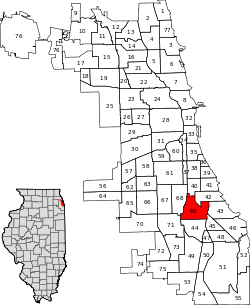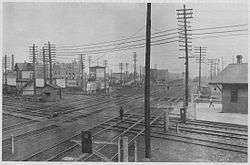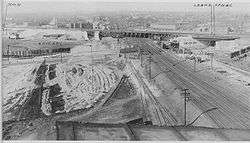Greater Grand Crossing, Chicago
| Greater Grand Crossing | |
|---|---|
| Community area | |
| Community Area 69 - Greater Grand Crossing | |
 Lem's Bar-B-Q restaurant on Grand Crossing's 75th Street business district. | |
 Location within the city of Chicago | |
| Coordinates: 41°45.6′N 87°36.6′W / 41.7600°N 87.6100°WCoordinates: 41°45.6′N 87°36.6′W / 41.7600°N 87.6100°W | |
| Country | United States |
| State | Illinois |
| County | Cook |
| City | Chicago |
| Neighborhoods |
List
|
| Area | |
| • Total | 3.56 sq mi (9.22 km2) |
| Population (2015) | |
| • Total | 32,346[1] |
| Demographics (2015)[1] | |
| • White | 1.44% |
| • Black | 96.07% |
| • Hispanic | 1.11% |
| • Asian | 0.01% |
| • Other | 1.36% |
| Time zone | UTC-6 (CST) |
| • Summer (DST) | UTC-5 (CDT) |
| ZIP Codes | parts of 60619, 60620, 60621 and 60637 |
| Median income | $26,515[1] |
| Source: U.S. Census, Record Information Services | |
Greater Grand Crossing is one of the 77 community areas of Chicago, Illinois. It is located on the city's South Side.
History
The name "Grand Crossing" comes from an 1853 right-of-way feud between the Lake Shore and Michigan Southern Railway and the Illinois Central Railroad that led to a frog war and a crash that killed 18 people.[2]


The crash was the result of Chicago mayor Roswell B. Mason illegally constructing railroad tracks across another railroad company's tracks. Due to the lack of safety at the crossing, trains made complete stops here and therefore industry developed around the area to cater to the railroad workers of mostly Irish, Scottish, English, and German descent. The area was further developed by Paul Cornell throughout the 1870s and grade separation occurred at the rail crossing in 1912.[3]
Demographics
By the 1930s, the railroad workers residing in the neighborhood were joined by Swedes and Italians. Throughout the next two decades, African Americans began moving into the neighborhood from the overcrowding Black Belt and that's when Grand Crossing's White residents began to move out of the neighborhood. During the 1950s, the Black population of the neighborhood rose from 6% to 86%. Today, the neighborhood is 97% Black.
Transportation
The CTA's Red Line provides 24/7 service to Grand Crossing at the 69th Street and 79th Street stations. Additionally, the Metra Electric line provides commuter rail service at the 75th Street (Grand Crossing) station at 75th Street and South Chicago Avenue at the railroad crossing that gave the neighborhood its name.
Features
The Oak Woods Cemetery, established in 1854, is located in Greater Grand Crossing.
Since 2006, Artist Theaster Gates has redeveloped several buildings in Grand Crossing as art and community centers.[4]
References
- Paral, Rob. "Chicago Community Areas Historical Data". Chicago Community Areas Historical Data. Archived from the original on 18 March 2013. Retrieved 29 August 2012.
- Profile: Greater Grand Crossing by Jeanette Almada Chicago Tribune (October 7, 1998)
- 1 2 3 "Community Data Snapshot - Greater Grand Crossing" (PDF). cmap.illinois.gov. MetroPulse. Retrieved November 29, 2017.
- ↑ "Greater Grand Crossing". www.encyclopedia.chicagohistory.org. Retrieved 2016-01-15.
- ↑ http://encyclopedia.chicagohistory.org/pages/547.html
- ↑ Can artists save Grand Crossing?
External links
| Wikimedia Commons has media related to Greater Grand Crossing, Chicago. |
 |
Washington Park, Chicago | Woodlawn, Chicago |
| ||||
| Englewood, Chicago | |||||||
| South Shore, Chicago | |||||||
| Auburn Gresham, Chicago | Chatham, Chicago | Avalon Park, Chicago |